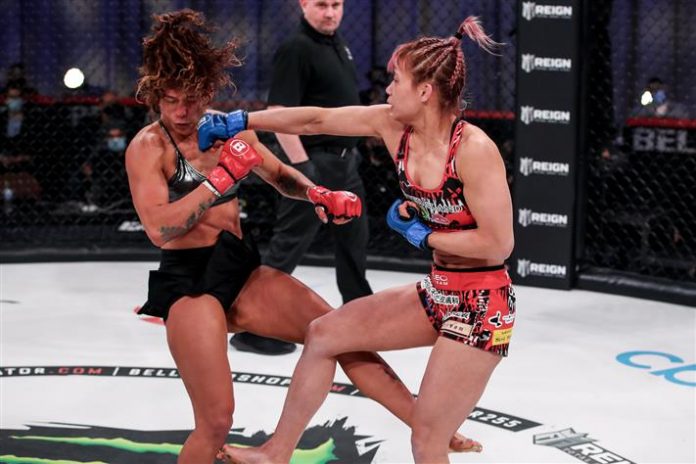
From duels in the cage to donuts, Kana Watanabe is an interesting character.
But then, that’s something that Japanese fighters seem to excel at: character. Personality. Getting over with the audience.
While western MMA promotions have clung to the notion that to be a sport, mixed martial artists must have uniformity, Japanese fight promotions have always mixed sport and spectacle. When Cageside Press spoke to Watanabe ahead of Bellator 261, she pointed out that most Japanese MMA stars have their own Youtube channel, for starters.
“I’m not quite sure how it is outside of Japan, but in Japan there’s this weird thing where all fighters have their own Youtube channel, and they all create their own content,” Watanabe (10-0-1) explained ahead of her Bellator 261 co-main event scrap with fellow top flyweight Liz Carmouche. “It’s just something in Japan that’s just part of what a professional fighter does. They have their own Youtube channel, and create their own content and show the fans a different side of fighting.”
In terms of balance, Watanabe added, “I do think the Japanese culture and Japanese fighting have more chances for when it comes to showing life outside of being a fighter.” Take, for example, the undefeated flyweight’s donut challenge, that saw her chow down on 17 of the popular pastry.
The donut eating video, Watanabe added, was just something she just thought of. The Japanese fighter, albeit just a tad embarrassed at the attention, admitted that she has a sweet tooth — count anything extra sweet, with cream inside or chocolate covered, among her favorites. “I’ve never done a donut challenge, so I decided to do it. I was pretty happy that I could eat at least ten donuts, but it’s probably something I would never do again.”
Still, the quirky videos, colorful entrances, and overall showmanship of Japanese fighting remains lacking in the west. So why make the move to a North American promotion like Bellator? In a word, competition.
“There are a few reasons why, but one of them is that it’s just so hard, the lack of competition in Japan. The flyweight division in Japanese women’s MMA, it’s not quite strong,” Watanabe admitted. “It’s a fairly weak division, and I was having a hard time getting constant fights with quality opponents. So that’s one of the reasons why.” The other major reason, she added, was to fight globally, a goal she’s had since making the transition from judo to MMA. Watanabe has always desired to “fight in international competitions, and hopefully fight at the highest level against high-quality opponents,” she added.
As to the differences between fighting at home and in the west, one of the biggest has been the size difference of her opponents. “The physical strength and the size difference from fighters in the same division” have been noticeable, Watanabe revealed. But despite finding a size and strength difference in comparison to Japanese opponents, Watanabe hasn’t felt like she’s been dominated physically thus far.
“I was able to hold my own physically against a strong opponent. Right now, I haven’t put in extra work in my physical training, I’ve actually been putting emphasis on my skills and training technique,” she said. “I do think that if you don’t have the skills and technique, you will be overwhelmed by the physical strength of your opponent.”
Then there’s the move from a ring in Japan to a cage in North America — something Watanabe feels actually benefits her. “I like to utilize my cage wrestling, and I think a cage helps me with my strengths,” she suggested. “As a judo practitioner, I’ve got a lot of throws, I’ve got a lot of trips, where you know a ring, sometimes we can fall out of a ring, the ropes get caught, interfere with what I want to do. So I do feel that the cage definitely fits more for my fighting style.”
One downside of the move to Bellator has been seeing her weight cut complicated by travel, however. “I did feel that, in my last fight, the weight cutting process was a lot more complicated than just cutting weight and making weight in Japan.” Fortunately, Watanabe added, she did make weight. Still, “there was a lot to learn from my last fight,” she continued. “And this time I’ve learned everything I could from my last experience. Hopefully I can get prepared more in Japan to make my next weight cut easier in the States. I’ll be prepared.”
Against Carmouche, Kana Watanabe is facing a two-time UFC title challenger, and nearly unquestionably her strongest foe yet. “As far as the match-up goes, I think our styles match up well. It’ll be a fun fight where our strong points compliment each other,” she suggested.
When it comes to Carmouche, “she’s very good at setting the pace,” Watanabe noted. “She’s very good at implementing what she wants to do, and forcing her opponents to fight her fight.” The Japanese fighter’s goal is to do the opposite, not fight Carmouche’s fight, and “stir up the pace a little bit.”
The outcome of Carmouche vs. Watanabe has carried with it the unofficial label of title eliminator, especially given its status as the Bellator 261 co-main event — and because flyweight champ Juliana Velasquez makes her first title defense less than one month later.
That aspect of the bout has not been lost on Watanabe, who agreed it could be a possibility, but one that is dependant on outcome, and what the winner displays come fight night. “I think this is a fight where the position is that, depending on the result and depending on the performance, I think the winner will most likely get a shot at the title. But I think it all depends on the performance for both of us.”
Bellator 261 takes place this Friday, June 25, 2021 at the Mohegan Sun Arena in Uncasville, CT. The event airs live on Showtime in the U.S., following prelims right here on Cageside Press.
For more from Kana Watanabe, here’s her full Bellator 261 virtual media day scrum:


















